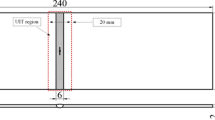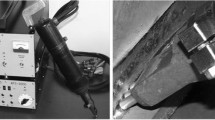Abstract
Fatigue strength of welded joints is improved by inducing compressive residual stress at weld toes. The ultrasonic impact treatment (UIT) is regarded as an effective method for inducing compressive residual stress at weld toes. However, excessive loads that cause plastic deformation at weld toes relieve the induced compressive residual stress. In addition, stress fluctuation affects the relaxation of residual stress even it is smaller than the yield strength. The relaxation of compressive residual stress decreases the fatigue strength improvement. Therefore, in order to evaluate the fatigue strength of welded joints enhanced by UIT, it is necessary to quantify the relaxation of local residual stresses at weld toes under cyclic loading. In this study, we measured a residual stress at the UIT groove using the X-ray diffraction method with a small-diameter collimator and an irradiation angle that was corrected based on the shape effect of the UIT groove, and we investigated its relaxation behavior under cyclic loading. In addition, we estimated the fatigue test results of the out-of-plane gusset joints improved by UIT using the modified Goodman diagram considering the relaxation of residual stress.













Similar content being viewed by others
References
Takahashi I, Yoshii T, Iidaka H, Fujii E, Matsuoka K (1991) Fatigue strength of non-load-carrying fillet welded joints using KE36 (TMCP) steel -effects of weld residual stresses and stress concentration factor. J Soc Nav Architects Jpn 169:267–277
Matsuoka K, Takahashi I, Fujii E (1992) Effect of yield stress on fatigue strength of non-load-carrying fillet welded joints. J Soc Nav Architects Jpn 171:417–425
Mori T, Shimanuki H, Tanaka M (2012) Effect of UIT on fatigue strength of web-gusset welded joints considering service condition of steel structures. Welding in the world 56:141–149
Statnikov ES (1997) Comparison of efficiency and processibility of post-weld deformation methods for increase in fatigue strength of welded joints. IIW Document XIII-1668-97
Marquis GB, Barsoum Z (2013) Fatigue strength improvement of steel structures by high-frequency mechanical impact: proposed procedures and quality assurance guidelines. Welding in the World 57(6):803–822
Statnikov ES, Vityazev V, Korolkov O (2005) Ultrasonic impact treatment ESONIX versus ultrasonic peening. IIW Document No. XIII-2050-05
Statnikov ES, Korostel V, Vekshin N, Marquis GB (2006) Development of Esonix ultrasonic impact treatment techniques. IIW Document No. XIII-2098-06
Yildirim HC, Marquis GB (2012) Fatigue strength improvement factors for high strength steel welded joints treated by high frequency mechanical impact. Int J Fatigue 44:168–176
Shimanuki H, Mori T, Tanaka M (2013) Study of a method for estimating the fatigue strength of welded joints improved by UIT. IIW Document No. XIII-2495-13
Shimanuki H, Tanaka M, Mori T (2015) Estimation method of fatigue strength based on the residual stress for the welded joint improved by ultrasonic impact treatment (UIT). IIW Document No. XIII-2603-15
Suzuki T, Okawa T, Shimanuki H, Nose R, Ohta N, Suzuki H, Moriai A (2014) Effect of ultrasonic impact treatment (UIT) on fatigue strength of welded joints. Adv Mater Res 996:736–742
APLIED ULTRASONICS HP; http://www.appliedultrasonics.com/solutions.html. Accessed 12 September 2019
Pulstec Industrial Co., Ltd. HP; https://www.pulstec.co.jp/en/product/x-ray/. Accessed 12 September 2019
Taira S, Tanaka K, Yamasaki T (1978) A method of X-ray microbeam measurement of local stress and its application to fatigue crack growth problems. J Soc Mater Sci 27(297):251–256
Sasaki T, Hirose Y, Single (1995) Incidence X-ray stress measurement for all plane stress components using imaging plate of two-dimensional X-ray detector. J Soc Mater Sci 44 (504): 1138–1143
SR202 committee (1991) Research on fatigue design and quality of welded parts in offshore structures. Shipbuilding Research Association of Japan
Mori T, Shimanuki H, Tanaka M (2010) Japan Society of Civil Engineers 2010 annual meeting, 65:I-099
Shimanuki H, Mori T, Tanaka M (2011) Japan Society of Civil Engineers 2011 annual meeting, 66:I-144
Shimanuki H, Mori T, Tanaka M (2012) Japan Society of Civil Engineers 2012 annual meeting, 67:I-260
Author information
Authors and Affiliations
Corresponding author
Additional information
Publisher’s note
Springer Nature remains neutral with regard to jurisdictional claims in published maps and institutional affiliations.
Recommended for publication by Commission XIII - Fatigue of Welded Components and Structures
Rights and permissions
About this article
Cite this article
Yonezawa, T., Shimanuki, H. & Mori, T. Influence of cyclic loading on the relaxation behavior of compressive residual stress induced by UIT. Weld World 64, 171–178 (2020). https://doi.org/10.1007/s40194-019-00821-1
Received:
Accepted:
Published:
Issue Date:
DOI: https://doi.org/10.1007/s40194-019-00821-1




